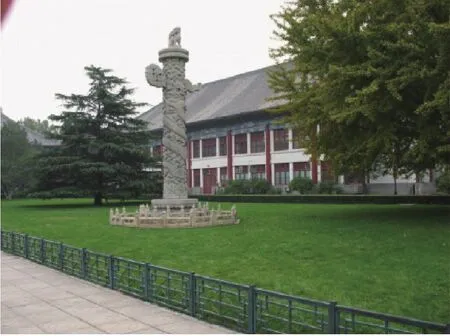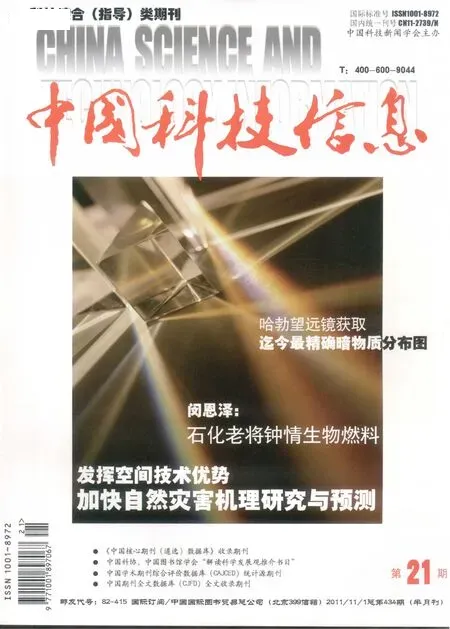国际科技信息
世界银行今日发布报告称,由于在教育和科研方面存在缺陷,东亚的大学在推动本国经济增长的进程中没能起到它们应起的作用。
该报告分析了造成此现象的原因,其中最重要的是职工对高级技能的需求与高校所提供的培训不匹配。此外,研究小组还发现大学研究并没有为工业和商业技术
国际科技信息
Hubble telescope captures new 'maps' of dark matter--But on this evidence, we may just have to take their word for it
Hubble's Cluster Lensing and Supernova Survey- CLASH - is charting the distribution of dark matter in 25clusters.
The Hubble scientists are scanning cluster galaxies, the most massive objects in the universe held together by gravity, to see if light is distorted by the dark matter inside the clusters.
The astronomers say the distortions produced by MACS 1206is evidence that the galaxies are largely 'made' of dark matter.
The distortions shown in the images would be far weaker if the only mass in MACS 1206was the mass of the stars and planets we can see.
CLASH uses the Advanced Camera for Surveys and the Wide Field Camera 3, the CLASH survey to covers a broad wavelength range, from ultraviolet to near infrared. Astronomers need the diverse colors to estimate the distances to lensed galaxies and study them in more detail.
These maps are being used to test previous results that suggest that dark matter is more densely packed inside clusters than some models predict.
MACS 1206lies 4.5billion light-years from Earth.
The era when the first clusters formed is not precisely known, but is estimated to be at least 9billion years ago and possibly as far back as 12billion years ago.
If most of the clusters in the CLASH survey are found to have excessively high accumulations of dark matter in their central cores, then it may yield new clues to the early stages in the origin of the universe.
哈勃望远镜获取迄今最精确暗物质分布图
借助哈勃空间望远镜和宇宙引力透镜效应,科学家们日前成功地获取了一个巨型星系团中暗物质迄今最精确的分布图。
暗物质是一种神秘莫测的不可见物质,它几乎占据了宇宙1/4的物质和能量,但是除了引力作用之外,它们和“常规”物质不发生任何相互作用。科学家们之所以知道宇宙中存在暗物质,并不是因为他们“看见”了暗物质,而完全是通过看不见的暗物质对可见物质施加的引力影响间接地获得关于它们的信息。
当大量暗物质聚集,就像常规物质组成的星系团中会包括数百甚至数千的星系一样,聚集的暗物质会产生巨大的引力作用,使其背后遥远星系发出的光线在经过其附近时发生弯曲,从而形成类似透镜的效应。地球上的天文学家已经拍摄到多幅同一个星系在引力中心四周形成多幅图像和假象的现象,这称为“引力透镜效应”。引力透镜效应可以作为我们很好的测量工具,用以估算一个星系中暗物质的多少,但到目前为止,天文学家们对于暗物质具体到底存在于哪个位置还是一无所知。
但是这次不同,借助哈勃空间望远镜搭载的先进巡天相机(ACS),天文学家们已经找出了一个叫做阿贝尔1689(Abell 1689)的星系团中暗物质分布的具体位置。
“使用其他方法,研究者只能是通过很多观测数据去拼凑一个暗物质的质量分布情况,找出一种最符合观测数据的分布模型,”美国宇航局喷气推进实验室(JPL)的天文学家丹科尔(DanCoe)在一次新闻发布会上表示,“但如果使用我们的方法,研究者将可以直接获得暗物质的质量分布图,而不必去猜测和拼凑。”
阿贝尔1689星系团距离地球22亿光年,含有大约1000个星系和10000亿颗恒星。通过对比哈勃的图像和之前早先的观测数据,研究人员从中挑选出了42个不同背景星系的135张不同照片。“发生引力透镜效应的天体照片就像是一个大大的迷宫,”科尔说。“我们所做的,就是第一次对阿贝尔1689星系团的内部质量进行排布,以便找到某种质量分布模式,在这种模式下将产生我们所观测到的背景星系引力透镜效应。”
科尔和同事们在哈勃望远镜的图像上叠加上暗物质的位置信息(即题图中的蓝色物质)。这一结果已经发表于11月10号的《天体物理学报》,在这一份研究论文中,科尔和同事们确认了阿贝尔1689星系团中的暗物质量要比先前研究人员们根据其星系规模做出的估算值要高。
这一多出的物质量说明星系团在宇宙早期形成的年代要早于天文学家们原先的估计。暗物质的引力作用使物质聚集,但这一过程却受到另一种更加神秘的强大力量的阻碍,这就是“暗能量”它的主要效应是将物质推开。一旦早期宇宙中暗能量扮演了重要角色,星系团要想聚集在一起难度就会大得多。
“因此,星系团的形成应当在此之前数十亿年便开始形成,以便形成我们今天所看到的宇宙。”科尔说。“在早期宇宙中,宇宙空间更小,暗物质的密度也更高。阿贝尔1689星系团似乎在诞生初期就聚集了大量周遭的物质。在那之后,这个星系团便一直带着这多余的质量,直到今天被我们观测到。”
这一研究成果是一个名为“哈勃星系团透镜和超新星巡天”(CLASH,缩写意为“撞击”)的一部分。在接下来的三年时间内,该计划还将利用哈勃空间望远镜观测25个星系团,总观测时长将达一个月。
Sun's 11-year cycle means we're in for Arctic freeze this winter, say scientists
It's been a lovely Indian summer - but it could come back to bite us.
That's what scientists predict after working out the first ever pattern of activity for the sun.
According to research, the sun runs on an 11-year cycle -and this affects winter weather over the northern hemisphere.
The study says low solar activity can contribute to cold winters in the UK, northern Europe and parts of America.
Which is bad for us - because the sun is just emerging from a so-called solar minimum, when solar activity is at its lowest.

It means after a baking hot September, we could be in for a repeat of last year's big freeze.
But the study also raises the possibility that weathermen can predict cold winter weather over the northern hemisphere using the solar cycle.
Dr Adam Scaife, from the Met Off ce, one of the study's authors, said: 'Our research establishes the link between the solar cycle and winter climate as more than just coincidence.
'We've been able to reproduce a consistent climate pattern, conf rm how it works, and quantify it using a computer model.
'This isn't the sole driver of winter climate over our region, but it is a signif cant factor and understanding it is important for seasonal to decadal forecasting.'
Up until now, researchers have only managed to see a weak link between solar activity and winter weather.
It was understood that when the sun is less active, we're more likely to see weak westerly winds during the winter in the northern hemisphere.
This pattern suggests that easterly winds could bring cold weather from the continent to the UK.
But scientists have struggled to incorporate these ultraviolet (UV) signals into climate models.
Today's f ndings, published in Nature Geoscience, used satellite measurements from NASA's Solar Radiation and Climate Experiment (SORCE) to reveal that differences in UV light reaching the Earth during the 11-year solar cycle are larger than previously thought.
The satellite, launched in 2003, is the first ever to measure solar radiation across the entire UV spectrum.
Professor of atmospheric physics, Joanna Haigh from Imperial College London, said: 'The instrument on the SORCE satellite divides UV light up into small wavelength regions, providing good spectral resolution.
'Before this, climate models used broad spectral bands, so couldn't reveal the solar signal.'
Using this new information in a Met Off ce climate model, researchers from the Met Off ce and the University of Oxford demonstrated that it's possible to reproduce the effects of solar variability which show up in climate records.
It seems that in years of low UV activity, unusually cold air forms over the tropics in the stratosphere, around 30miles up.
This is balanced by a more easterly f ow of air over the mid latitudes – a pattern which then makes its way down to the Earth's surface, bringing easterly winds and cold winters to northern Europe.
But when solar activity is higher than usual – around the peak of the 11-year solar cycle – the opposite happens: strong westerly winds bring warm air and so milder winters to Europe.
Lead author Sarah Ineson, from the Met Office, said: 'What we're seeing is UV levels affecting the distribution of air masses around the Atlantic basin.
'This causes a redistribution of heat – so while Europe and the US may be cooler, Canada and the Mediterranean will be warmer, and there is little direct impact on global temperatures.'

太阳活动影响地球天气北半球将迎来寒冬
科学家表示太阳的11年活动周期能够影响北半球的冬季天气。研究指出较弱的太阳活动与英国、欧洲北部和美洲部分地区的寒冷有关。目前,太阳正进入所谓的“太阳活动极小期”。这也就意味着,在经历了9月的酷暑之后,北半球将再次迎来2010年那样的寒冬。
这项研究发现提高了天气预报人员利用太阳活动周期预测北半球冬季天气的可能性。研究论文作者、英国气象局的亚当·斯凯菲博士表示:“我们的研究发现太阳活动周期与冬季气候之间的联系并不是一种巧合。我们能够找到一个可靠的气候模式,确定其如何运转并通过电脑模型进行量化。太阳活动并不是影响我们地区冬季气候的唯一因素,但却是一个重要因素。加深对太阳活动影响的了解对预测天气非常重要。”
直到现在,研究人员仍只发现太阳活动与冬季天气之间存在较弱的联系。太阳活动较弱时,北半球的冬季更有可能出现较弱的西风。在这种气候模式下,东风能够将大陆的寒冷天气带到英国。
一直以来,科学家便很难将紫外线信号融入气候模型。根据刊登在《自然·地球科学》上的研究发现,研究人员利用美国宇航局“太阳辐射和气候实验”卫星(SORCE)的测量数据,揭示出11年的太阳活动周期中抵达地球的紫外线变化情况,所存在的差异超出此前的预计。这颗卫星2003年发射升空,是第一颗在整个紫外光谱测量太阳辐射的卫星。
伦敦帝国学院大气物理学教授乔安娜·海赫指出:“SORCE卫星携带的设备能够将紫外线分割成小波长区,提供出色的光谱分辨率。在此之前,气候模型使用较宽的光谱带,无法揭示出太阳信号。”通过将这些新信息融入气象局的气候模型,气象局和牛津大学的研究人员证明“复制”太阳活动变化产生的影响具有可行性。
研究发现,在紫外线较弱的年份,距地面30英里(约合48公里)的热带同温层形成异乎寻常的冷空气。与此同时,中纬度地区上空出现更多东风,进而达到一种平衡。这种现象随后向地球表面移动,为欧洲北部地区带来东风并迎来寒冬。当太阳活跃程度超过正常水平时——处于11年活动周期峰值左右——便会出现相反的现象,强烈的西风带来暖空气,让欧洲迎来温冬。
研究论文主执笔人、气象局的莎拉·伊纳森表示:“根据我们的研究发现,紫外线水平影响大西洋盆地周围的气团分布,导致热量重新分配。也就是说,在欧洲和美国出现低温天气时,加拿大和地中海却较为温暖。这种现象只能对全球温度产生极少的直接影响。”
How Black Death Kept Its Genes but Lost Its Killing Power
In f ve years, Black Death wiped out an estimated 30to 50percent of Europe's population. This medieval plague was caused by the bacterium Yersinia pestis, which still circulates among humans. Genetic clues as to what might have made it so deadly, however, had remained interred with the tens of millions of victims.
After careful extraction of genetic material from victims' teeth, a team of researchers has sequenced 99percent of the Plague's genome—the f rst whole-genome reconstruction of a disease from skeletal remains. The draft genome is described online October 12in Nature. (Scientific American is part of Nature Publishing Group.)
The 660-year-old plague DNA was isolated from four victims, who had been exhumed from London's East Smithf eld Cemetery in the 1980s by the Museum of London Archaeology. To get samples from the skeletal remains, physical anthropologist Kristen Bos of McMaster University in Ontario and a colleague found themselves "wiggling the teeth out of the skulls at the Museum of London," she said in a Tuesday press brief ng about the new study.
After carefully extracting genetic material from the inner pulp chamber of the teeth (so as not to damage their exteriors), the team created what Bos called a genetic "f shing rod," baited with molecules from modern-day Y. pestis. With that as a lure, "we were able to essentially f sh out the small preserved fragments of Yersinia pestis DNA" and separate it from the stew of human, bacterial and other genetic material that had accumulated during centuries in the soil. (The team described the actual method, which uses high-throughput DNA sequencing and microRNA enrichment, in an August Proceedings of the National Academy of Sciences paper.)
The genome now gives researchers a sort of "fossil" to start to map out the bacterium's phylogenetic tree. They discovered that the Black Death that devastated Europe between 1347and 1350was likely close to the common ancestor of all extant Y. pestis strains, (which likely arose—from the soil bacterium Yersinia pseudotuberculosis—between 1200and 1340).
If this was "the first big pandemic with disseminated Yersinia pestis in humans," as Johannes Krause, of the University of Tübingen's Institute for Archaeological Sciences, asserted at the briefing, then previous plagues, such as the sixthcentury Plague of Justinian, were either caused by a completely different pathogen or by a strain of Y. pestis that proceeded to go completely extinct.
The new family tree can also help researchers examine related groups, such as the types of plagues that currently affect only rodents (such as Microtus strains and those that have been found in Chinese marmots)—and what genetic changes might need to occur to allow them to infect humans.
The sequenced strain has some 4.7million base pairs. When compared with the modern version (based on 17different genomes), there are just 90genetic substitutions. That such few genetic changes occurred over the years, Krause said, was "really surprising."
Among these changes, none obviously explains ancient Black Death's virulence, Hendrik Poinar, also of McMaster, said during Tuesday's prepublication brief ng. "There's no particular smoking gun."So if the slight genetic differences in the disease were not responsible for its drastic change, what did make it so deadly in the 14th century that, as Bos described it, "people honestly thought it was the end of the world"?

Much of the mortality might be explained by situational factors, Poinar explained. Cooler climatic conditions and an excess of rain had led to failed crop harvests and widespread hunger, in addition to large numbers of people living in crowded—and already pathogen-filled—medieval cities. "You probably had an immunocompromised population, living under very stressful conditions," Poiner said. Add to that a "population being hit by Y. pestis maybe for the first time," and "Black Death was the perfect storm."
Humans have also adapted to the disease. The global population has likely built up some immunity from centuries of exposure to the pathogen. And even before the modern era, virulence was likely quelled by cultural adaptations, Krause noted. During the first outbreak, no one knew what kind of disease it was nor how to treat it, he said. During subsequent outbreaks, however, "people had already developed some kinds of adaptations—they had developed quarantines, they had developed first aid to treat patients with the symptoms."
加拿大科学家主导成功破解黑死病基因密码
加拿大
麦克马斯特大学“古代DNA中心”主管波拿亚和德国图宾根大学克劳斯领导的研究小组成功破解黑死病基因密码,成果报告见于12日出版的《自然》期刊上。
波拿亚表示,即使是一年前,想要取得这种级数的基因资料,可以说是发白日梦。
他表示,他跟同事估计黑死病有如此杀伤力,可能是该种病原首次入侵人类,亦不会有人有抗生素作保护,加上当时的环境令疾病快速传播,包括房屋和城市非常挤迫、欠缺卫生设备、人们普遍营养不良以及尚未发现抗生素和抗病毒药物等。
波拿亚指出,曾研究基因组的抗生素专家相信,将治疗今天瘟疫的药物用于14世纪,应该同样有效。
在英国伦敦东部的伦敦塔附近一个大规模的黑死病死者墓穴中,从掘到的人类牙齿发现了DNA破片,让科学家得以完成这种古代鼠疫杆菌的完整序列。研究人员是从4副颚骨的牙齿取得DNA,4名死者中,两人是成年女性,另1人是未能确定性别的青少年,至于第4人的性别和年龄均无法识别。他们利用现代鼠疫杆菌基因序列做样本,得以完成14世纪瘟疫的基因排列。
波拿亚表示,仍未能肯定基因排列的正确顺序,若能掌握或许有助解释古代细菌为何如此致命。
研究人员亦跟美国的科学家协作尝试寻找该等基因的改变。
科学界对于自1347年到1351年肆虐的黑死病成因,长期争论不休。部份科学家认为是一种病毒性出血热引致,这种引发瘟疫的流行病学模式跟今天的瘟疫明显有别。
波拿亚的研究开创性地将肆虐多个世纪的一种前所未见、杀伤力极大的细菌的演化绘成图表。时至今日,这种细菌仍在发展中国家局部地区肆虐。
据此间的星岛日报13日报道,14世纪中期欧洲发生长达5年的黑死病恐慌期,大约造成5000万人死亡。
East Asia's Universities Need To Play Bigger Economic Role, Says World Bank
low and should be increased, preferably through performance-Universities in East Asia aren't giving their countries the economic boost they should because of educational and research shortcomings, concludes a report released today by the World Bank. In Putting Higher Education to Work: Skills and Research for Growth in East Asia, a team of bank experts says reforms and better funding could position universities and postsecondary vocational schools to improve economic productivity and competitiveness particularly in the developing countries of Southeast Asia, China, and Mongolia.
The problem stems from a number of what the report calls "disconnects." The most important is a mismatch between the advanced skills needed in the workforce and the training provided at universities and other post-secondary institutions. The team also found that university research was not contributing to the technological advancement of industry and commerce. Other gaps include a lack of interaction between universities and national research institutes and inconsistent secondary schooling.
Universities are now operating in isolation, the authors argue, instead of as part of an integrated system designed to meet strategic needs. Specific recommendations start with increasing funding for higher education and encouraging more students to go beyond secondary schools—particularly in science, technology, engineering, and math—by providing scholarships and loans. The report notes that with the exception of several more advanced countries—Korea, Japan, and China—spending on R&D as a share of GDP is relatively based funding such as competitively awarded grants. And few of these countries have university technology licensing efforts, public-private matching research funding programs, or other schemes to forge university-industry ties. The team also concludes that most of the region's universities would benef t from better management and governance and greater autonomy.
For most of these challenges, the report provides examples of best practices drawn from within the region. "We don't want to preach" to educational and government leaders, James Adams, World Bank's regional vice president, said at the report's launch today in Tokyo. Rather, the goal is to provide comparative information for decision-makers to work with.

世界银行报告称东亚各大学应发挥更大经济作用的提升做出贡献。其它因素则包括大学与国家科研机构之间缺乏交流,以及中学教育与大学教育脱节等。
世界银行今日发布报告称,由于在教育和科研方面存在缺陷,东亚的大学在推动本国经济增长的进程中没能起到它们应起的作用。
该报告分析了造成此现象的原因,其中最重要的是职工对高级技能的需求与高校所提供的培训不匹配。此外,研究小组还发现大学研究并没有为工业和商业技术
在这份名为《高等教育的实际应用:东亚发展所需要的技术与科研》的报告中,研究小组表示,对于许多国家——特别是东南亚发展中国家、中国以及蒙古而言,对高校进行改革并提供更多资助,能使其在提高经济生产力和竞争力方面发挥积极作用。
该报告建议加大对高等教育的资金投入,并且提供奖学金和助学贷款以鼓励更多学生接受高等教育——尤其是在科技、工程和数学领域。报告还指出,除韩国、日本和中国等较发达国家之外,其他东亚国家在科研发展领域的投入较少、所占国内生产总值的比重相对较低,所以应当加大投入,最好能以学术表现作为经费资助的基准,通过提供竞争性奖励等方式实现。报告还总结认为,一套好的管理制度以及更多自主权,将有利于大多数区域性大学的发展。
IBM Exhibit Visualizes Today's Urban Problems--and Potential Solutions
At first glance the mammoth screen running down a former parking ramp at Lincoln Center looks like something on loan from Times Square, about a dozen blocks to the south. But this 37.5- by 4.3-meter digital data-visualization wall, parked in the heart of Manhattan, is offering much more than enticements to buy snacks or the latest cologne.
Watch the animated screen a little longer, though, and you will learn something—about the city's largely untapped potential to collect solar energy, the amount of water from New York State's reservoirs wasted before it ever reaches urban residents, and the patterns in traffic and air quality that change hourly. You are seeing data that have been harvested by IBM from 100sensors throughout the city, analyzed for patterns and rendered into visualizations to create a more complete picture of the city's oft-ignored problems and potential solutions.
"Think," a free exhibit on display at Lincoln Center through October 23, consists of three parts: At the lower end of the ramp, visitors move past the digital wall into a small theater f lled with 20massive video columns, each 2.4meters tall and 1.2meters wide. The columns are covered front and back by video screens that, when dark, resemble the primordial monolith from 2001: A Space Odyssey. They are arranged in clusters that immerse the audience for a 10-minute film highlighting scientific and technological progress in areas including space exploration, personalized medicine, traff c management and agriculture around the world. At the conclusion of the f lm, all 40video screens convert into large interactive touch panels. This lets the audience drill down on different topics via maps, timelines and images.
View a slide show of IBM's Think exhibit.
As visitors leave the theater they can see the f nal part of the exhibit—a timeline of key IBM milestones from the past century. Starting with the events leading up to Thomas J. Watson's founding of the Computing-Tabulating-Recording Co. in June 1911from the merger of four firms to the company's name change to International Business Machines in 1924all the way through the recent success of the company's Watson artif cial intelligence program on the game show Jeopardy!.
Think is one of several ways IBM is celebrating its centennial anniversary this year. The exhibit however, is curiously light on advertising for "Big Blue"—as the company was previously nicknamed—and focuses more on what the company's technology is doing behind the scenes to address health care, resource conservation, food production and other 21st-century concerns. Short interactive videos in the exhibit's theater feature IBM researchers such as David Ferrucci (who led the development of Watson) as well as scientists such as Howard-Yana Shapiro, global director of plant science and external research at Mars Inc.
"We wanted to do something that would be open to the public," says IBM's Lee Green, vice president of brand experience and strategic design. "IBM hasn't done anything like this since probably 1964when Charles and Ray Eames designed the IBM exhibition at the World's Fair in Flushing Meadows, New York." That exhibit, much less subtle, featured a dome resembling a company innovation, the electric typewriter ball, albeit with only the letters I, B and M.
"What they did so well was take the complexity of math, science and technology and simplif ed it," Green says. "We wanted to do the same thing, [telling] stories about what it is possible to achieve today through science and technology." IBM plans to tour the exhibit to science museums and educational institutions when it completes its stay at Lincoln Center.

New form of superhard carbon observed

Carbon is the fourth-most-abundant element in the universe and takes on a wide variety of forms, called allotropes, including diamond and graphite. Scientists at Carnegie's Geophysical Laboratory are part of a team that has discovered a new form of carbon, which is capable of withstanding extreme pressure stresses that were previously observed only in diamond. This breakthrough discovery will be published in Physical Review Letters.
The team was led by Stanford's Wendy L. Mao and her graduate student Yu Lin and includes Carnegie's Hokwang (Dave) Mao, Li Zhang, Paul Chow, Yuming Xiao, Maria Baldini, and Jinfu Shu. The experiment started with a form of carbon called glassy carbon, which was first synthesized in the 1950s, and was found to combine desirable properties of glasses and ceramics with those of graphite. The team created the new carbon allotrope by compressing glassy carbon to above 400,000times normal atmospheric pressure.
This new carbon form was capable of withstanding1.3 million times normal atmospheric pressure in one direction while confinedu n d e r a p r e s s u r e o f600,000 times atmosphericlevels in other directions.N o s u b s t a n c e o t h e rthan diamond h a s beenobserved to withstand thistype o f p ressure s t re s s,indicating t h a t t h e newc a r b o n a l l o t rope m u s tindeed be very strong.
However, unlikediamond and other cry stalline for msofcarbon, the structure of this new material is not organized in repeating atomic units. It is an amorphous material, meaning that its structure l a c k s t h e l o n g-r a n g e order of cr ystals. This amorphous, superhard carbon allotrope would have a potential advantage over diamond if its hardness turns out to be isotropic-that is, having hardness that is equally strong in all direwcions. In contrast, diamond's hardness is highly dependent upon the direction in which the crystal is oriented.
"These findings open up possibilities for potential applications, including super hard anvils for high-pressure research and could lead to new classes of ultradense and strong materials," said Russell Hemley, director of Carnegie's Geophysical Laboratory.
IBM推出网游CityOne直指城市问题
IBM周一推出了一款名为“CityOne”的网络游戏,希望通过该游戏让玩家体验当前城市所面临的一些问题,并启发玩家寻求解决问题的方法。最终,IBM希望通过该款游戏来刺激公司的服务和软件营收。
IBM软件业务副总裁南希皮尔森(Nancy Pearson)称,用户可以选择四大行业:银行、零售、水和能源,然后试图解决相关问题。例如,监控城市的水质量,或者是能源的供应情况等。
皮尔森称,该游戏可提升人们对IBM新服务的意识和销售额。当前,IBM正在推行智慧地球(Smarter Planet)计划,从而帮助企业和政府部门利用数字技术更好地进行决策。IBM此前曾表示,到2015年该项技术可给IBM带来100亿美元的销售额。
从周一起,用户可免费下载该款游戏。目前,已经有7000多人注册下载,其中包括大学、政府和企业会员。南希称,如果有任何问题,用户可以通过互联网与IBM代表进行交流。
美研发出非结晶新型碳结构材料——应付超强压力的能力可能超过金刚石
据美国物理学家组织网10月11日报道,碳是宇宙中储量占第四的一种元素,其有几种同素异形体,最常见的两种单质是高硬度的金刚石和柔软滑腻的石墨。现在,美国科学家们制造出了一种新形式的碳,其应付超强压力的能力让金刚石“自愧弗如”。该突破性发现将发表于《物理评论快报》杂志。
斯坦福大学的毛温迪(音译)和其研究生林宇(音译)领导的科研团队与卡内基研究所地球物理实验室的科学家们共同做出了这项发现。他们让碳的一种——玻璃碳承受40万倍的大气压力,制造出了这种新的碳的同素异形体。玻璃碳于上世纪50年代才被首次合成,其兼具玻璃、陶瓷和石墨烯的一些特质,应用范围很广。
科学家们发现,新形式的碳在一个方向上能经受130万倍的大气压力,在其他方向上能承受60万倍的大气压力。除了金刚石之外,没有其他物质能承受如此大的压力,这表明,这种新的碳的同素异形体的确很坚硬。
然而,与金刚石和其他形式的碳晶体不同的是,这种新材料是一种非结晶的物质,这意味着它的结构缺乏晶体的长距离有序性。
如果这种非结晶的、超硬的碳的同素异形体各个方向的硬度一样的话,其潜能优势比金刚石还强。金刚石的硬度主要取决于晶体的取向。
卡内基研究所地球物理实验室的主任罗素·赫姆利说:“最新发现将有很多应用领域。科学家们或能据此制造出高压研究所需要的超硬铁砧以及其他超致密、超硬的新材料。”

